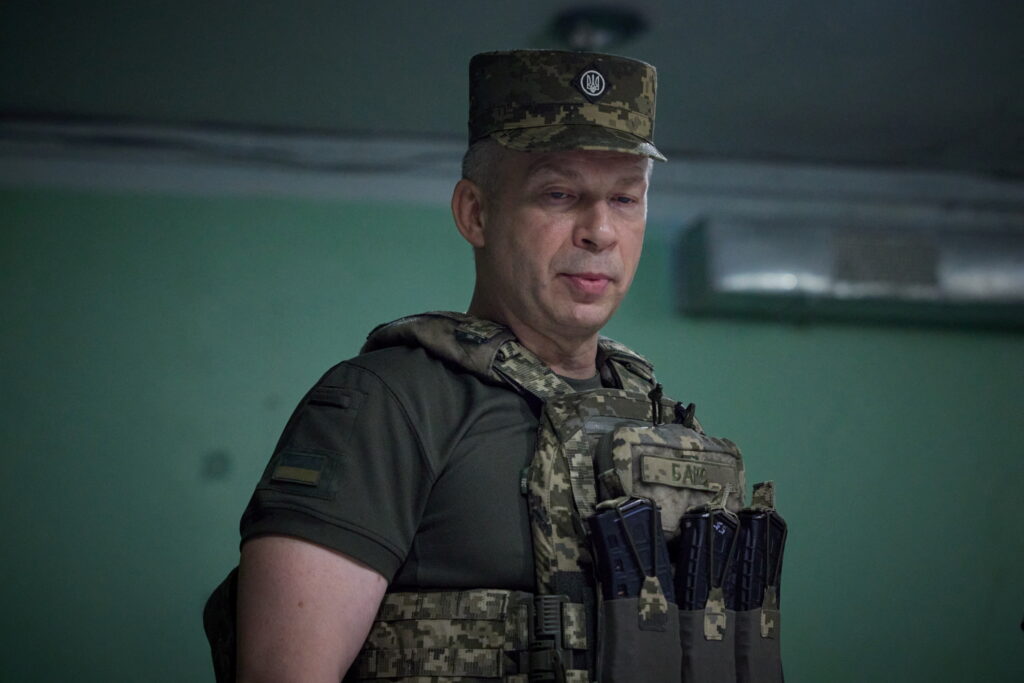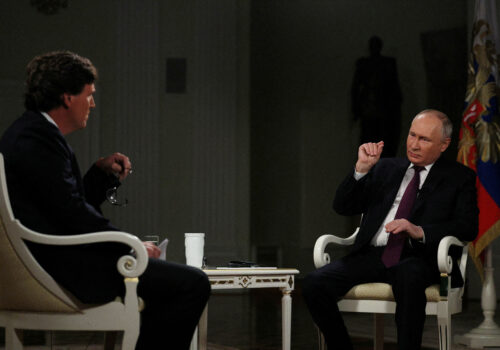Can Ukraine’s new army chief overcome mounting battlefield challenges?
Oleksandr Syrsky does not have the luxury of easing into his new job. As Russia’s full-scale invasion of Ukraine approaches the two-year mark, Ukrainian President Volodymyr Zelenskyy recently tapped Syrsky as Ukraine’s new commander-in-chief in the biggest shakeup of Ukraine’s military leadership since the start of the war. As Ukraine’s top general, Syrsky must now come to grips with a range of mounting difficulties facing the Ukrainian military due to a combination of battlefield deadlock, manpower challenges, and shortages in vital aid from the country’s Western partners. He is already facing a major test of his leadership in overseeing the increasingly desperate defense of Avdiivka, a strategically important frontline city in eastern Ukraine that has been the scene of bitter fighting for the past five months and is now on the verge of falling to Russia.
Syrsky is one of Ukraine’s most experienced and decorated generals, having served as a senior commander since the early days of Russian aggression in 2014. Following the onset of the full-scale invasion in February 2022, he was responsible for some of Ukraine’s most spectacular victories, including the defense of Kyiv and the successful counteroffensive of September 2022 that led to the almost complete liberation of the Kharkiv region in northeastern Ukraine.
While Syrsky’s appointment did not come as a surprise, it has sparked a lively debate within Ukrainian society. Ukraine’s new army chief is widely seen as a competent military professional, but he does not enjoy anything like the popularity of his predecessor, Valery Zaluzhny. Syrsky has also been criticized for his leading role in the battle of Bakhmut, which raged for months in late 2022 and early 2023 with heavy losses on both sides.
Syrsky inherits a challenging and in many ways unfavorable military situation. Ukraine has not achieved any major advances since the November 2022 liberation of Kherson, with Ukrainian troops unable to breach Russia’s extensive fortifications during the 2023 campaigning season. In recent months, Russia has resumed offensive operations along the one-thousand-kilometer front, forcing Ukraine to revert to active defense. Speaking to German TV channel ZDF in his first interview since his appointment, Syrsky acknowledged that the battlefield initiative had now passed to Russia and confirmed that Ukraine was engaged in defensive operations with the goal of maximizing Russian losses.
Ukraine’s new commander-in-chief is acutely aware that simply holding the front will not be enough. The Ukrainian army’s lack of progress in 2023 is already leading to questions over the feasibility of a Ukrainian victory and fueling calls for a negotiated settlement that would likely leave Russia in control of areas it currently holds. This would mean abandoning millions of Ukrainians to permanent Russian occupation, while also setting the stage for future waves of Russian aggression that would place Ukrainian statehood in doubt.
To maintain international support for the war effort, it is vital for the Ukrainian military to demonstrate that it is capable of repeating the triumphs of 2022. However, Syrsky must do so with dwindling resources. In recent months, weapons deliveries to Ukraine have declined sharply, with the future of US military aid becoming hostage to domestic politics. This has forced Ukrainian troops to ration ammunition and has left them increasingly outgunned at numerous hot spots along the front. In such conditions, it will be extremely difficult for Ukraine to mount any significant offensive operations. “We have enough resilience and courage. We lack support, ammunition, and equipment,” Syrsky said in his ZDF interview.
In addition to ammunition and weapons shortages, Syrsky must contend with the same unresolved manpower issues that contributed to his predecessor’s downfall. Zaluzhny had pushed for the mobilization of an additional half a million Ukrainians, but Zelenskyy was reluctant to back the call-up of so many men. Mobilization legislation is now under consideration in the Ukrainian parliament and remains the subject of heated public discussion. Zelenskyy will be looking to Syrsky for solutions that will make it possible to rotate frontline soldiers and maintain the country’s current lines of defense without fueling social tensions.
As he approaches these formidable challenges, Syrsky will be able to call upon a team of relatively young commanders who have also been promoted as part of Zelenskyy’s recent shakeup. This new generation of officers are mostly in their forties and represent a further step away from the old Soviet mindset that once dominated Ukrainian military thinking. They have all gained extensive combat experience over the past ten years and have strong reputations as battlefield innovators.
These officers will now be expected to take the lead as the Ukrainian army looks to counter Russia’s overwhelming advantages in manpower and conventional military resources by utilizing drones and electronic warfare tools to maximum effect. Ukraine is already prioritizing the domestic production of drones, while Zelenskyy recently announced the creation of a separate drone warfare branch within the Ukrainian Armed Forces. Integrating new drone technologies into combat operations will be a priority during the coming year.
In addition to widespread battlefield deployment, Ukraine has also used drones successfully in the Black Sea to sink a series of Russian warships and has recently launched a long-range drone campaign against Russia’s oil and gas industry. These initiatives now look set to expand further. With uncertainty surrounding the future of weapons deliveries from Ukraine’s Western partners, the sustainability and economic viability of drone warfare mean that it is likely to play an increasingly prominent part in Syrsky’s offensive planning for 2024.
Syrsky is taking charge of the Ukrainian military at a critical moment in the war with Russia. He is under enormous political pressure to demonstrate that Russian President Vladimir Putin can still be defeated, but he currently lacks the troops and resources to embark on any major offensives. Instead, his most realistic objective in 2024 will be to hold the front and prevent Russia from regaining territory liberated by Ukraine in late 2022. While maintaining a predominantly defensive posture, he will also be looking for opportunities to strike meaningful blows to the Russian war machine behind the lines, in the Black Sea, and inside Russia itself.
Peter Dickinson is editor of the Atlantic Council’s UkraineAlert service.
Further reading
Thu, Feb 15, 2024
Ukraine’s Black Sea success offers hope as Russian invasion enters third year
UkraineAlert By Peter Dickinson
Ukraine’s remarkable success in the Battle of the Black Sea exposes the emptiness of Russia’s red lines and provides a road map for victory over Putin, writes Peter Dickinson.
Mon, Feb 12, 2024
Putin’s history lecture reveals his dreams of a new Russian Empire
UkraineAlert By Peter Dickinson
Vladimir Putin turned his hotly anticipated interview with Tucker Carlson into a history lecture that laid bare the dangerous delusions and imperial ambitions driving the invasion of Ukraine, writes Peter Dickinson.
Thu, Jan 11, 2024
Arsenal of Autocracy: North Korea and Iran are arming Russia in Ukraine
UkraineAlert By Olivia Yanchik
Together with Iran and North Korea, Russia has succeeded in establishing an Arsenal of Autocrats that now threatens to plunge the world into a new era of war and insecurity, writes Olivia Yanchik.
Image: Commander of the Ground Forces colonel general Oleksandr Syrskyi reports to Ukraine’s President Volodymyr Zelenskiy at a position near the front line, amid Russia’s attack on Ukraine, in Donetsk region, Ukraine June 26, 2023. Ukrainian Presidential Press Service/Handout via REUTERS



